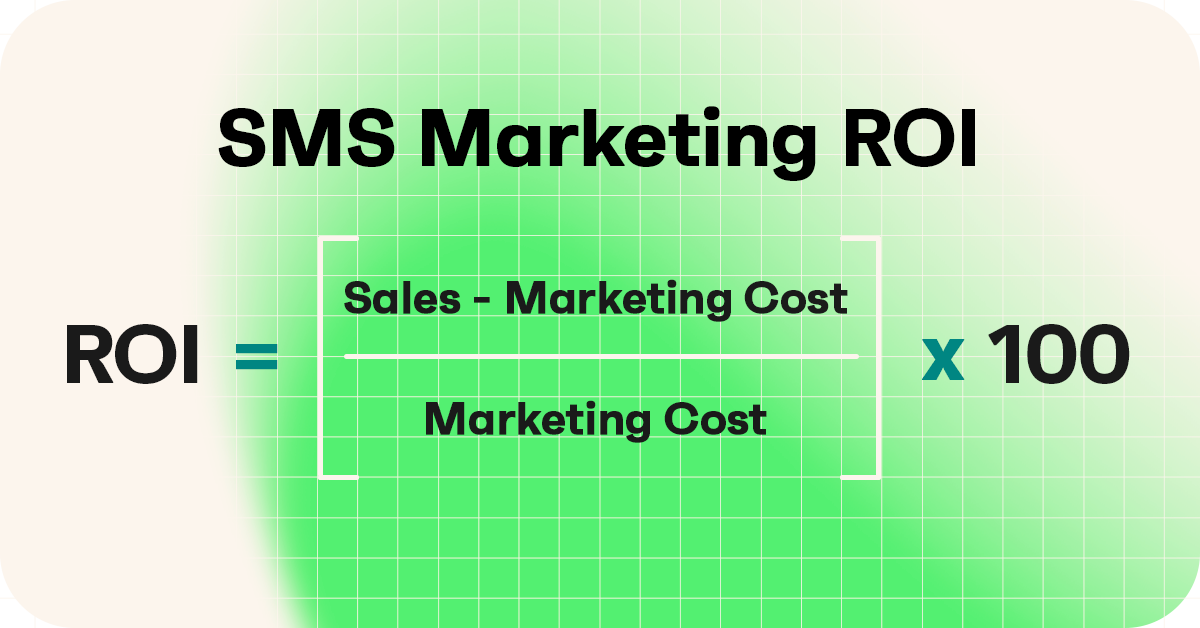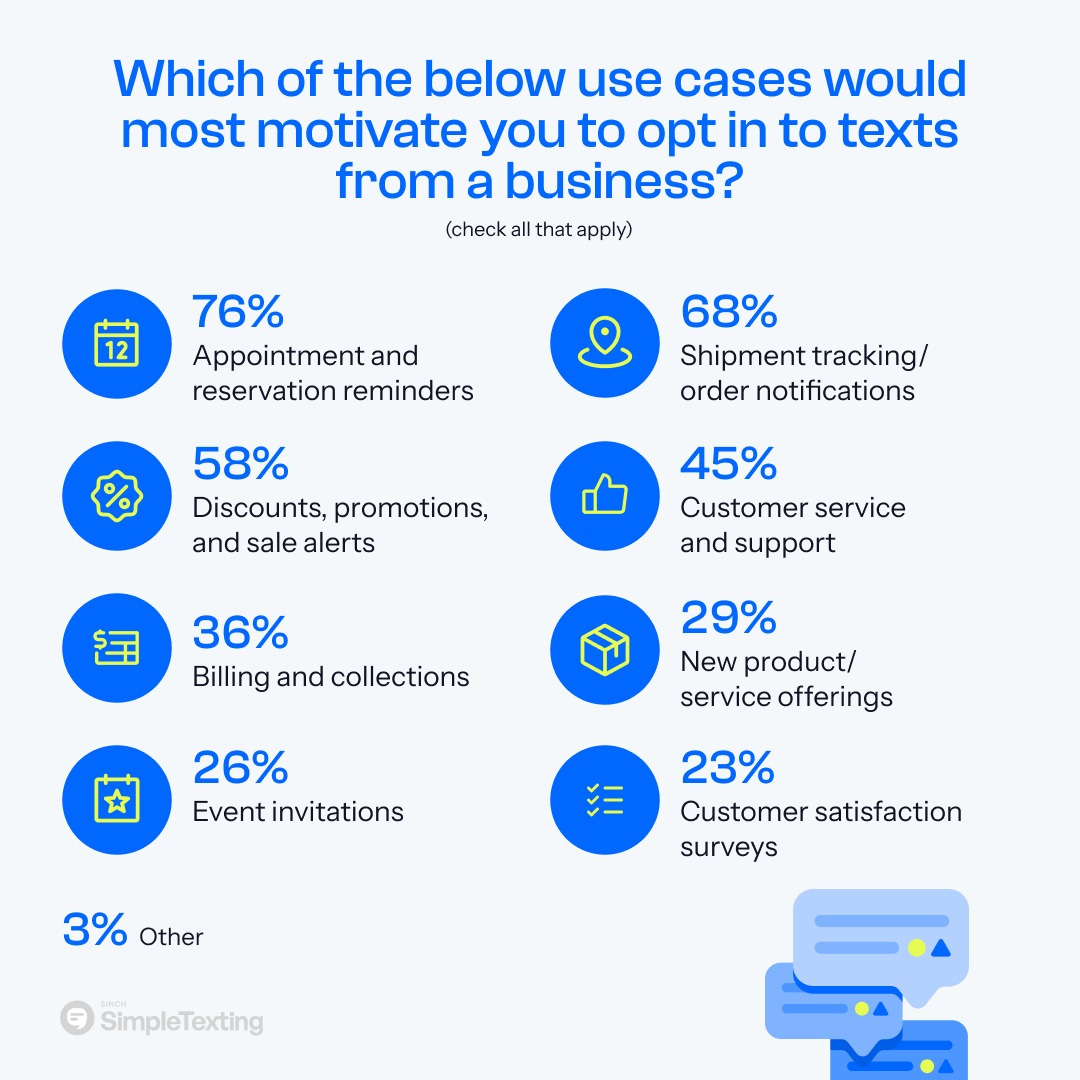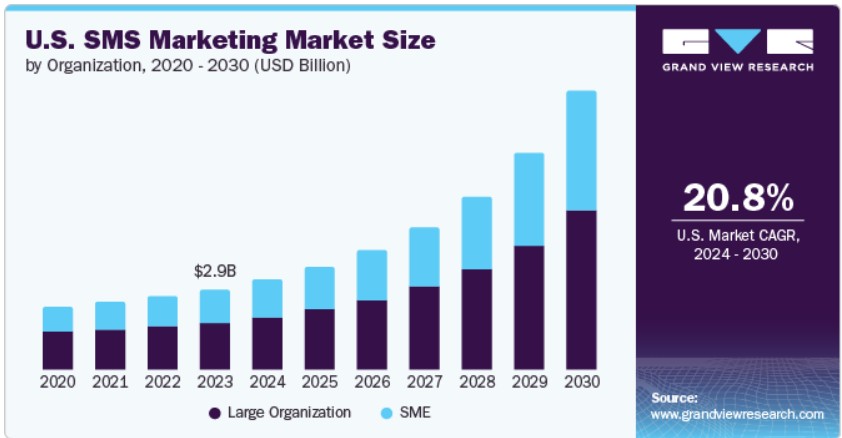Drive sales on autopilot with ecommerce-focused features
See FeaturesSMS marketing data in 2025 clearly shows that this strategy remains strong and is thriving due to how responsive consumers are to it.
People are tired of crowded inboxes and fleeting social posts. So, what works? A direct, personal message that reaches them in real time. That’s exactly what SMS marketing delivers.
Many brands turn to this approach because it offers what other channels often miss: immediacy. This is why SMS marketing has become integral to modern marketing strategies.
In this article, we’ll break down the most crucial SMS marketing statistics, trends, and benchmarks for 2025. By the end, you’ll see why SMS marketing has become an important marketing tool for brands that want to grow and stay relevant.
Quick sign up | No credit card required
What are the key SMS marketing benchmarks?
In a side-by-side comparison with email marketing statistics, SMS marketing data highlights how SMS can reach audiences more effectively. Here are some key benchmarks to watch out for.
Open rates
The 98% open rate is one of the most common SMS marketing stats, but it needs context. While some campaigns can achieve this level, a more realistic industry range is 90% to 98%. Even at the lower end, SMS outperforms email, which only averages 28.6%.
What matters most among SMS marketing facts isn’t that SMS reaches the most amount of people, but that nearly every message sent is actually seen. This level of visibility makes SMS an unmatched communication channel.
Engagement rates
High open rates are impressive, but they don’t give a complete picture of SMS marketing performance. The real advantage of SMS lies in what we call engagement velocity. This is the speed at which users interact with a message after receiving it.
SMS marketing analytics show the following data:
- 90% of SMS messages are read within three minutes
- The average SMS response time is 90 seconds, compared to 90 minutes for email
With instant engagement, marketers can grab customers’ attention when they’re most receptive.
Click-through rate
When it comes to compelling recipients to take action, SMS once again sets the standard. The average SMS click-through rate ranges between 21% and 35%, with some industries reporting rates as high as 40%. By comparison, email averages just 3.25% CTR.
Conversion rate
SMS marketing effectiveness becomes even clearer when we examine conversions. On average, 21% to 30% of SMS recipients complete a purchase or desired action. Email, by contrast, converts at an average of 12.04%. This gap shows why SMS is one of the most effective ways to drive measurable business results.
Unsubscribe rate
A common concern with direct communication is channel fatigue, but SMS marketing performs competitively here as well.
According to recent SMS market data, unsubscribe rates remain consistently below 3.5%, and in many cases, fall under 1.5%. This is significantly lower compared to the average email unsubscribe rate of 1.35%.
Customers who opt into SMS do so intentionally, and their low attrition rates indicate that they value the immediacy.
Here’s a quick view of how text message marketing statistics stack up against email in 2025:
| Metric | SMS marketing data | Email marketing data |
|---|---|---|
| Open rate | 90–98% | 28.6% |
| Engagement velocity | 90% read in three minutes, average response of 90 seconds | Average response of 90 minutes |
| Click-through rate | 21–35% (up to 40% in some industries) | 3.25% |
| Conversion rate | 21–30% | 12.04% |
| Unsubscribe rate | <3.5% | 1.35% |
Is SMS marketing ROI better than email and other channels?
What makes SMS marketing even more valuable is its ability to provide a measurable return on investment. Recent SMS marketing data shows that businesses generate an average of $71 for every $1 spent on SMS marketing.
Even conservative estimates put returns between $21 and $41 for every dollar invested, as compared to the email ROI of $10 to $36.
This success comes down to two key factors: effectiveness and efficiency. SMS achieves higher open and conversion rates than email, while subscriber acquisition costs can be as low as $0.45.
Beyond the ROI, SMS marketing data shows the tangible value of each message sent. Automated flows, such as abandoned cart reminders, are lucrative, generating $3.07 to $10.78 in earnings per message (EPM).
Some industries push these numbers higher. For example, in the automotive sector, SMS campaigns deliver an average revenue per message (RPM) of $19.14.
Each message carries meaningful financial weight, which is why SMS drives such exceptional ROI.
How to calculate your SMS marketing ROI
Understanding the potential of SMS is one step, but calculating your own ROI takes it further. The formula is straightforward:
ROI = (Revenue – Cost) ÷ Cost × 100

Here’s an example:
Suppose you spend $50 on an SMS campaign, and that campaign generates $300 in sales.
Your ROI = (300 – 50) ÷ 50 × 100 = 500%

With this simple formula, you can estimate your SMS marketing cost and track the financial impact of your campaigns.
What consumer behavior data tells us about SMS marketing
The effectiveness of SMS marketing is rooted in consumer demand. Text messaging statistics show that 84% of consumers have opted in to receive text messages from businesses, and over 52% receive SMS from four or more brands.
This preference positions SMS as a unique tool for building direct, trusted connections with audiences.
Why consumers opt in
SMS marketing data reveals that people subscribe for specific, practical reasons. The leading reason is appointment and reservation reminders, with 76% of consumers opting in so they never miss an important date or booking.
Close behind, 68% of subscribers sign up to receive shipment tracking and order updates. Discounts, promotions, and sale alerts are another major driver, with 58% of consumers subscribing to stay ahead of special offers and discounts.

How SMS influences buying
Beyond subscriptions, SMS has a measurable impact on sales. SMS marketing statistics show that 75% of consumers report purchasing after receiving a text from a brand. This proves its ability to move consumers from awareness to action.
Even more telling, 65% admit they bought items sooner than planned because of a timely message.
Frequency and timing of SMS marketing campaigns
Despite its strengths, SMS marketing comes with limits. Customers appreciate consistent engagement but only within reasonable boundaries.
Studies show that 49% of subscribers are comfortable with at least one text per week. If bombarded with too many messages, 53% will unsubscribe.
Relevance is more important than volume. When brands respect these boundaries, unsubscribe rates remain low.
Businesses should also consider the best time to send texts for better engagement. Text marketing stats show that 45% of consumers make purchases via SMS during the evening when they’re more relaxed.
All in all, SMS marketing data shows that when businesses provide real value, customers reward them with loyalty and conversions. When brands cross the line into over-messaging, they lose that trust.
How many businesses are using SMS marketing in 2025?
More and more businesses are adopting SMS marketing in 2025 as well as dedicating significant portions of their budgets to it.
On average, companies now allocate 18.76% of their total marketing budget for SMS campaigns. That’s nearly one-fifth of all marketing spend directed toward a single channel.
Additionally, over 64% of businesses plan to increase their SMS marketing costs next year.
In terms of market size, the US SMS marketing industry is projected to grow from $2.9 billion in 2023 to $9.96 billion in 2030, growing at a compound annual growth rate (CAGR) of 20.3%.

Globally, SMS advertising spend alone is expected to hit $809.05 million in 2025, with the US accounting for nearly $318.5 million of that figure.
SMS marketing numbers make one point clear: SMS isn’t a side channel. With billions invested, rising adoption across industries, and consistent year-over-year budget growth, SMS marketing has established itself as a global marketing tool.
Which industries see the highest SMS marketing performance in 2025?
SMS marketing yields strong results in several sectors, but some industries stand out in 2025. The latest SMS marketing data shows that adoption, engagement, and conversion rates vary depending on how businesses use the channel.
High adoption industries
SMS marketing data shows that certain industries have embraced SMS usage at near-universal levels.
- For example, healthcare leads with 83% adoption, using texts for appointment reminders, follow-up care, and patient updates
- Hospitality follows at 80%, leveraging SMS for booking confirmations, reservation changes, and last-minute promotions
- Finance comes in at 72%, with banks and financial services relying on SMS for alerts, fraud notifications, and marketing
- Ecommerce/retail also accounts for a major share, around 66% of all SMS-sending businesses

High engagement and conversions
In terms of engagement, text marketing statistics also highlight where SMS campaigns achieve the most substantial returns.
- In finance, 72% of companies report click-through rates above 20%, a high engagement that’s a result of the immediacy of financial alerts and timely offers
- Hospitality sees the highest conversion rates, with 69% of businesses reporting that their SMS campaigns convert at 20% or higher
- Finance and consumer services also perform well, with 67% of businesses achieving conversions over 20%
These SMS statistics show this channel’s ability to drive both engagement and revenue across varied sectors.
SMS marketing trends to watch in 2025
SMS marketing is evolving into an interactive channel to build stronger, two-way connections.
In 2025, three key trends are converging to redefine how businesses connect with customers via SMS. Let’s take a closer look at each of these trends.
The rise of conversational commerce
SMS is no longer limited to one-way notifications. It’s becoming a dynamic two-way channel where customers can get real-time support and complete purchases, all within a single conversation.
Customers can browse products, ask questions, receive tailored recommendations, and finalize a transaction without leaving the SMS thread. For brands, this creates seamless buying journeys that reduce friction and drive more conversion rates.
This shift is powering the growth of conversational commerce, a market currently valued at $11.26 billion in 2025.

AI-driven personalization at scale
Artificial intelligence is at the center of this SMS marketing era. AI enables businesses to personalize messages at scale, resulting in relevant and effective interactions.
Research shows that 81% of companies already report improved SMS performance after implementing AI tools. Leading use cases include analyzing customer data for targeting purposes (47.7%), personalizing messages based on customer actions (45.4%), and optimizing message timing (41.6%) to maximize engagement.
Perhaps most striking, 37% of businesses report that AI saves them between four and six hours each week. These SMS marketing data demonstrate that AI is a catalyst for smarter, faster, and more impactful SMS campaigns.
RCS (Rich Communication Services)
Rich Communication Services (RCS) are the next evolution of text messaging, bringing app-like experiences to the native inbox.
With RCS, brands can send high-resolution images, videos, product carousels, and even verified sender IDs without third-party apps.
Adoption is accelerating, with Apple’s support leading to a 500% surge in global RCS traffic in 2024. The service was projected to grow the number of active users to 2.1 billion worldwide by 2026.
The performance data is equally compelling. RCS campaigns are achieving engagement and conversion rates of up to 50%. For marketers, RCS reveals powerful layers of creativity within mobile messaging.
The three trends, conversational commerce, AI-driven personalization, and RCS, are converging to create an intelligent messaging ecosystem. AI provides the brainpower to deliver relevance. Conversational commerce sets the stage for customer engagement and transactions.
Meanwhile, RCS provides the infrastructure for richer, interactive experiences, forming the foundation of the future of SMS marketing.
How can you use SMS marketing data to grow your brand?
SMS usage generates a steady flow of insights, including open rates, click-throughs, and SMS opt-in rates that can guide you in making smarter marketing decisions.
Below is a simple four-step framework you can follow to turn SMS marketing data into a real growth strategy.
Step 1: Benchmark your performance
Start by comparing your SMS marketing data against industry averages. You can use metrics like click-through rate, conversion rate, and unsubscribe rate to identify where you stand out and where you lag behind.
Benchmarking helps keep your strategy grounded in reality and ensures you’re aiming for measurable improvement.
Step 2: Refine your cadence and timing
Your SMS usage patterns matter as much as the content itself. Data shows that 49% of consumers prefer to receive promotional texts once per week. If your unsubscribe rate is higher than 1.5%, scale back frequency to align with that preference.
Timing also plays an important role. You can test different send times, monitor results, and adjust until your engagement rates peak.
Step 3: Align content with consumer motivation
Why do subscribers opt into SMS lists in the first place? Clearly, to receive discounts and exclusive deals, or just to get timely updates.
So, adjust your strategy to emphasize offers, limited-time promotions, or urgent alerts that align with subscriber motivations.
Step 4: Measure and prove your ROI
Finally, translate your performance into business results. Use the ROI formula outlined earlier to calculate how much revenue SMS contributes compared to costs.
Use your ROI data to secure buy-in. When you can show decision-makers and stakeholders that every resource invested in SMS brings back more, it becomes much easier to win more budget. With more resources, you can expand campaigns, test new ideas, and keep scaling results.
FAQs
SMS marketing remains one of the most effective channels for customer engagement. Businesses continue to report open rates between 90% and 98% according to recent SMS marketing data, which far outperforms email and push notifications.
The right frequency depends on your audience and message type. However, SMS marketing data shows that most customers are comfortable with one to two texts per week. Going beyond this can lead to fatigue and unsubscribes.
SMS marketing data shows that the market continues to grow rapidly in 2025. This is fueled by rising mobile phone use and strong consumer demand for direct communication. Current estimates project the global market size to surpass $90 billion in the coming years, making it one of the fastest-growing areas in digital marketing.
The future of SMS marketing lies in greater personalization, automation, and integration with other channels. Expect brands to rely more on AI-driven segmentation, conversational messaging, and rich media, such as MMS. As privacy regulations tighten, SMS will also become a trusted opt-in channel for building one-to-one relationships.
TABLE OF CONTENTS
TABLE OF CONTENTS


No fluff, no spam, no corporate filler. Just a friendly letter, twice a month.

 OFFER
OFFER







